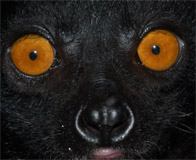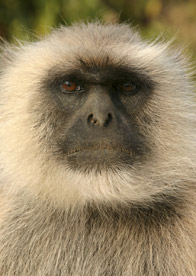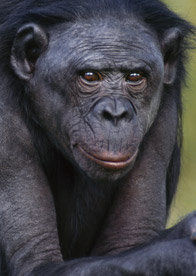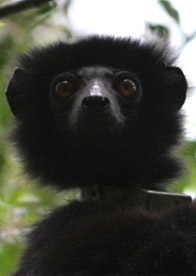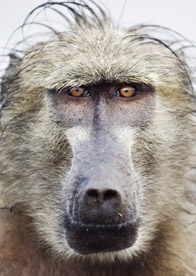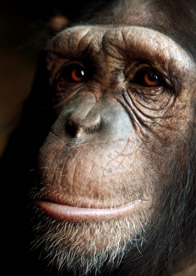Killer Instinct
by Peter Tyson
Why is infanticide so widespread among primates,
including the great apes, and what does that say
about
us?
By almost any standard, lemurs are adorable, like a child's
stuffed animal come alive. "Yellow Silver," a wild male lemur
I once had the pleasure of observing close up in a Madagascar
rain forest, epitomized this cuteness. Reclining on a
hammock-like vine just six feet away, he was so close I could
smell his bushy black fur and see his human-like fingernails
and eyelashes. Totally ignoring me, he draped one hand lazily
over a twig and now and then curled up his two-foot tail
chameleon-style then let it unfurl. Yellow Silver was dozing
off a hot afternoon—a picture of idle contentment.
Years later I learned that Yellow Silver, like many of his
kind, was an infant-killer. Patricia Wright, the primatologist
who named him and is studying his species, the Milne-Edwards'
sifaka, told me recently what it's like to witness an
infanticide. A male will distract a female holding a baby by
biting her on the elbow or shoulder. "The baby's exposed, and
then the young male"—Wright sucks in her
breath—"just gets the baby and slits the belly. The baby
lets go and drops to the ground. We're all screaming and
crying because it's so awful. The baby doesn't die right away,
so it's very, very painful."
Polar-opposite images of Yellow Silver: easygoing fur ball,
savage killer. How did such behavior, which to us humans is
both shocking and puzzling, arise in nature? That is, how
could a species bent on passing on its genes possibly benefit
by killing its own members? Infanticide is widespread in the
animal kingdom, occurring in rats and lions, wasps and tree
swallows, sand sharks and sea lions. But it is its presence
among primates, including our closest relatives, the chimps
and gorillas, that I find most compelling, in an unsettling
way. To wit: What does its existence among the great apes say
about us?
Challenging an old bias
The realization that infant-killing occurs widely in nature is
relatively recent. In large part this had to do with our
repellence of the act. Charles Darwin set the tone when he
wrote, in The Descent of Man, "Our early semi-human
progenitors would not have practiced infanticide, for the
instincts of the lower animals are never so perverted as to
lead them regularly to destroy their own offspring." As late
as the mid-1960s, classical ethology—the study of animal
behavior in the wild—held that creatures rarely killed
members of their own species, except in captivity or
unnaturally crowded conditions.
A sea change in this view began to sweep over biologists in
the early 1970s. It was triggered by a Harvard graduate
student named Sarah Hrdy, who went to India at the time to
study Hanuman langurs. Fed by Indians, who consider them
sacred, these black-faced monkeys live in dense populations
near cities. Hrdy went to investigate reports of violent
behavior among the langurs, including infanticide. "My working
hypothesis was that I was going to be looking at pathological
behavior brought about by crowding," Hrdy told me. "Within a
year, I had changed my mind."
Infanticide is not pathological in Hanuman langurs, Hrdy
decided. Rather, it appears to be a strategy males can use to
help them achieve reproductive success. When a male langur
enters a new group to breed, it's to his reproductive
advantage to kill off any unweaned infants and thus bring
their mothers more quickly back into fertility so he can mate
with them and pass on his genes. (A mother producing milk
cannot get pregnant.)
In the four decades since Hrdy's seminal work, biologists have
documented infanticide in some two dozen species of primates
and prosimians (lemurs and other lower primates). And it's not
only males. Female primates also kill babies, from
Milne-Edwards' sifaka females that kill others' infants in an
act Wright says may be simple competition, to the chimpanzee
mother and her daughter whom Jane Goodall famously observed
killing and eating baby chimps on several occasions.
(Altogether, Sarah Hrdy has identified five categories of
infanticide in nature—see sidebar.) But among primates,
mostly it occurs when young males like Yellow Silver enter a
new group to breed.
Ongoing debate
Not everyone agrees that Hrdy's hypothesis—known to
scientists as sexually selected infanticide by males—is
correct. Robert Sussman, an anthropologist at Washington
University in St. Louis, is one of the more vocal critics.
Sussman notes that infanticide among primates remains a
statistically uncommon event, and while more than two dozen
primate species documented as infanticidal may sound like a
lot, the number of recognized primate species tops 300, he
says.
Sussman also feels that all the conditions needed for Hrdy's
hypothesis—among them, that infanticidal males are more
reproductively successful than males that don't practice
infant-killing—are difficult to show in the wild.
Finally, any genetic link, which Hrdy's hypothesis presumes,
is even more challenging to demonstrate. "There's no evidence
whatsoever that there are males that carry genes for
infanticide," Sussman told me.
"If a male comes into the group and almost all the females are
lactating, he should try very hard to eliminate kids."
Hrdy acknowledges that finding genetic links to infanticidal
behavior in primates is a long way off. But she points to such
evidence in various types of rodents, in which some strains or
family lines have been shown to be more prone to infanticide
than others. (Sussman counters that these are laboratory
rodents in unnatural and stressful conditions.)
Yellow Silver's case
Notwithstanding detractors, most biologists today accept
Hrdy's hypothesis, including Pat Wright. Indeed, what Yellow
Silver did years after I saw him on that lazy afternoon
appears to be a textbook case of male sexually selected
infanticide, she says.
When male Milne-Edwards' sifakas reach six years of age, they
begin looking to join another group in which to breed. To
improve their chances of breeding successfully, they look for
a group with no male or only one male. Five years after I saw
Yellow Silver, he finally, at age nine, took over another
group—and the group's lone baby quickly disappeared. "We
didn't actually see him attack," Wright says. "That's good in
a way," she adds under her breath. "I'd rather not see it."
Wright didn't need to see the event to guess what had
happened—and why. Sarah Hrdy had predicted early on that
infanticide would not happen in seasonal breeders like lemurs,
because males would still have to wait until the next breeding
season for females to become fertile. (In Hanuman langurs, a
female becomes fertile just four days after her infant's
death.) So why do Yellow Silver and his fellow males kill
infants? The answer, Wright says, may be that they still gain
a reproductive advantage.
Milne-Edwards' sifaka groups are small, only three to nine
members, and females only breed every two years on average. If
a group has only one breeding male and two breeding-age
females—a common scenario—and an incoming male
like Yellow Silver kills any unweaned infants, the next year
the resident male may mate with one female and the immigrant
male with the other. (Wright has genetic evidence that
confirms this paternity outcome in two cases, she says.) Thus,
both males sire offspring that next year, which is a year
faster for both males than it would be if the unweaned babies
had lived.
"It's amazing, but we've seen it enough times and we've got
the genetic evidence now, so that seems to be it," Wright told
me. "It's a cruel game, though."
Mating with infant-killers
Females also play the game, if only by necessity. In lemurs,
females are dominant and get to choose males they mate with,
but they appear unable, either singly or collectively, to stop
incoming males from committing infanticide. (And they get no
help from resident males, which is, Wright says, "the most
shocking thing to me," as those males almost certainly
fathered the infants being attacked.) Moreover, the females,
as in Hrdy's langurs, mate with the very males that killed
their infants.
Ryne Palombit, a former student of Hrdy's who studies
infanticidal chacma baboons in Botswana, explains a possible
reason why. "Students in my classes ask me all the time, 'Why
don't the females just not mate with this guy?'"—meaning
an infanticidal male. "I call that the Lysistrata strategy,"
Palombit says, chuckling. In Aristophanes' 5th-century B.C.
play of that name, Greek women collectively go on a sex strike
and take over the cities in an effort to end the Peloponnesian
War.
"In theory, it could work," Palombit says, "but all the
females would have to boycott this male, because as soon as
one cheats and mates with him, she'll have a higher
reproductive advantage." Females are competing with one
another as well, and, as it happens, refusing to mate is
virtually non-existent among mammals, Palombit says. Wright
has seen only one instance among Milne-Edwards' sifakas, and
the spurned male finally left the group.
Suppressing the urge
While counterstrategies in some primate species are clearly
insufficient to prevent infanticide, in others they seem to
work. More than a third of infant deaths among chacmas are by
infanticide, but virtually none are among East African olive
baboons, a closely related species that Palombit also studies.
Palombit thinks it's because of a key difference in behavior.
In chacmas, once an alpha male takes control of a group, he is
the only one that mates with the group's females, and thus he
can feel confident that he'll be the father of any infants
conceived during his tenure. But his tenure as alpha is short,
averaging only seven or eight months. So it's to a new alpha's
benefit to kill unweaned young. "If a male comes into the
group and almost all the females are lactating," Palombit
says, "he should try very hard to eliminate kids,
because [otherwise] he won't have any reproductive success. Or
he should leave the group."
In olive baboons, Palombit says, an alpha's tenure lasts a lot
longer, up to two years, so he can afford to wait until
mothers wean their infants and resume cycling. Moreover, in
olives, two lower-ranking males can join forces and unseat the
alpha while females are ovulating, and thus an olive alpha can
never enjoy the same degree of confidence regarding paternity
that a chacma alpha enjoys. These reasons may be why
infanticide is rarely seen among olives, Palombit says.
Is a tendency towards infanticide buried in my genes or at
least in my distant past as a human being?
Bonobos seem to have found a different strategy for avoiding
infanticide—females have sex anytime, all the time, with
anybody, even other females and juveniles. "By having so much
sex with everybody, including the males, the females are
totally confusing paternity in a way," says Frans de Waal, a
primatologist at Emory University. "There is no male in the
group who can potentially exclude the possibility that he's
the father of an offspring." So, again, infanticide may confer
few if any reproductive benefits, and, in fact, it has never
been reported in bonobos.
The human factor
Not so in humans. In truth, some scholars believe infanticide
was an important factor in human evolution. "People have often
assumed that the origin of the human pair-bond lay in males
providing food for offspring," de Waal says. "But it may have
been simpler—they may have just been protecting
offspring [from infanticide]."
The practice still occurs today among humans, though, as Hrdy
stresses, it's quite different from that in non-human
primates. By far the most common form of infanticide among
people involves mothers themselves, she says, and it has to do
with local resources and how much social support the mother
has. Wherever mothers do not have access to other forms of
birth control, they sometimes have to resort to infanticide.
"Among !Kung hunter-gatherers in the Kalahari, about 1 percent
of live-born infants are abandoned at birth," she says. "It
usually has to do with birth spacing or perhaps birth defect
and is very regretfully done." In Highland New Guinea, on the
other hand, infanticide has been, Hrdy says, "off the charts,
since mothers will eliminate daughters in hopes of bearing a
son sooner."
Even in the United States, infanticide takes place on
occasion, and the genetic relatedness that, according to
Hrdy's hypothesis, wild males like Yellow Silver must weigh
before attempting the act may play a role in some cases. One
widely cited study by researchers at McMaster University in
Hamilton, Ontario found that a preschool American stepchild is
60 times more likely than a biological child to be the victim
of infanticide.
Getting personal
All this leads me to wonder: Just how different am I
fundamentally from Yellow Silver? When I first met the woman
who would later bear my two children, I never felt an urge to
kill off her four-year-old son from a previous marriage. But
is a tendency towards infanticide, even if suppressed, buried
in my genes or at least in my distant past as a human being?
I don't know, and even experts don't have a definitive answer
yet. But I certainly wasn't giving it any thought while
watching Yellow Silver do absolutely nothing on that warm day
in Madagascar. In fact, the lemur's languor was infectious,
and I, too, dozed off, probably a picture of idle
contentment.
